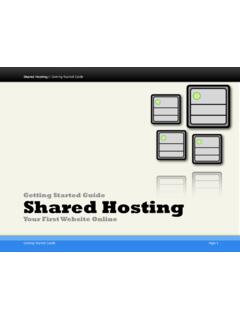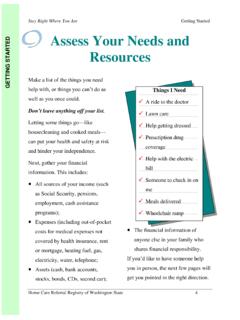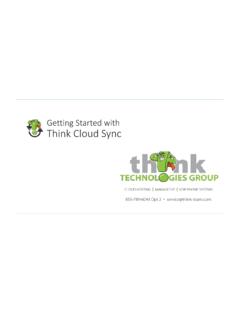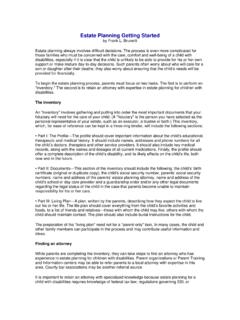Transcription of Replibit Recovery Toolkit Guide - training.securewebportal.net
1 Replibit Recovery Toolkit eFolder Replibit Replibit Recovery Toolkit 2017 eFolder, Inc. All rights reserved. Last Update: May 2017 Page 1. Replibit Recovery Toolkit Customer Support At eFolder, we want to help you quickly resolve your technical issues and value your input to build products that incorporate your suggestions! If you need assistance with set-up or any other technical questions or issues, please contact our Technical Support team at or call: 720-642-6389, and select 2 for technical support, then 1 for Replibit , which includes eFolder Replibit , or 678-888-0700, and select 2 for technical support, then 1 for Replibit , which includes eFolder Replibit . For known problem resolutions, open a browser and navigate to: Knowledgebase: 2017 eFolder, Inc. All rights reserved. Last Update: May 2017 Page 2. Replibit Recovery Toolkit Table of Contents Table of Contents .. 3. Overview of Features .. 5. getting started .. 5. The Taskbar .. 6. Disk 8. Disk and File Management.
2 8. Using Disk Manager to mount local disk 8. File 10. Accessing Windows Network 10. Drives and Paths: How Linux differs from Windows .. 11. Available 12. Clamtk .. 12. Fred .. 13. GParted .. 14. Hardware Info .. 15. Remote Support .. 15. Secure Erase (Scrub) .. 16. iSCSI Manager .. 16. iSCSI Manager .. 17. Shell (Linux Terminal) .. 17. 17. Recovery Wizard PREPARATION .. 18. Using the Recovery Wizard .. 19. Using the Disk Copy Wizard .. 23. Dissimilar Hardware Driver Injection .. 24. Benchmark tests .. 28. Disk Performance .. 28. CPU Performance .. 29. Burn-in Testing .. 29. 2017 eFolder, Inc. All rights reserved. Last Update: May 2017 Page 3. Replibit Recovery Toolkit Advanced Recovery Options .. 30. Manually Recreate the UEFI Boot Partition .. 30. Manual Driver Injection for Windows Server 2008 R2 or newer .. 31. Manual Partition Recovery .. 32. Repair a Damaged Boot Record (Server 2008 R2 or Newer) .. 34. Troubleshooting .. 35. No Network Available.
3 35. No Desktop Environment .. 35. NTFS Disk Will Not Mount with Disk Manager .. 36. Windows Server 2003 does not boot after Recovery .. 36. 2017 eFolder, Inc. All rights reserved. Last Update: May 2017 Page 4. Replibit Recovery Toolkit Overview of Features The Replibit Recovery Toolkit is a Linux Live CD containing a wealth of tools and utilities for performing system Recovery , diagnostics, troubleshooting, and general digital forensics. Note: The Replibit Recovery Toolkit supports both legacy MBR and modern UEFI system architecture. This utility contains: Replibit Bare Metal Restore Wizard: Recover protected systems from a Replibit Appliance or Vault, directly back onto your replacement hardware. Protected systems may be recovered onto either physical or virtual machine hardware. Replibit Driver Injector: Inject critical device drivers into an offline Windows operating system to allow it to boot properly after it has been recovered to dissimilar hardware.
4 Also included are tools for: disk partition Recovery and editing filesystem repair antivirus scanning offline Windows registry editing disk cloning and imaging. getting started The Replibit Recovery Toolkit is built on Linux, and contains a comprehensive set of utilities that should please even the most experienced Linux users. For those less familiar with Linux, the disc has been designed to look and feel as much like Windows as possible, and experienced Windows users should have little difficulty navigating the GUI environment. Some of the most common applications have shortcuts located on the desktop, and the application menu behaves similarly to the Windows Start menu. On the desktop, you will find the following items: Disk Manager Manages the mounting and dismounting of system disks File Manager Browse local and network files similar to Windows Explorer GParted Graphical Partition Management utility Recovery Wizard Recover systems from a Replibit Appliance or Vault Remote Support Link to eFolder Replibit ScreenConnect Portal 2017 eFolder, Inc.
5 All rights reserved. Last Update: May 2017 Page 5. Replibit Recovery Toolkit The Taskbar The system taskbar is located at the bottom of the desktop. This operates similarly to the Windows taskbar. The system Taskbar contains: Desktop Selector The Desktop Selector buttons allow you to toggle between two virtual desktops. After opening your Application windows, you can click on the selector buttons as shown, and easily alternate between them by clicking on each selector button. Launcher Menu The Launcher Menu is similar to a Windows Start menu. To open, click on the button in the bottom left corner as shown. Use the Launcher menu to navigate a list of installed applications as you do similarly in Windows. Quick Launch bar The Quick Launch bar contains icons for both Chrome (Chromium) and Firefox web browsers for your convenience. 2017 eFolder, Inc. All rights reserved. Last Update: May 2017 Page 6. Replibit Recovery Toolkit Task Tray The bottom right of the screen contains the Task Tray.
6 The Task Tray contains the Network Manager and the Shutdown Menu. To open the Network Manager, click on the Network icon in the Task Tray. There are options to enable, disable, or edit the current network configuration. The Shutdown menu is located in the bottom right corner of the Task Tray. To shutdown, click on the Power button. You can also restart, suspend, switch user, lock screen, or log out. (Using the Power button is identical to clicking on the Launcher Menu, and selecting Log Out.). 2017 eFolder, Inc. All rights reserved. Last Update: May 2017 Page 7. Replibit Recovery Toolkit Disk Manager Disk Manager is located on the Desktop, as well as within the Recovery Tools folder on the Launcher menu. Use Disk Manager to display the list of all attached disk devices in the system, and mount or dismount disk volumes for file access. Disk and File Management When the Replibit Recovery Toolkit initially boots, only the Linux operating system on the CD itself is mounted.
7 In order to browse and recover files from disks installed within the physical system, you will first have to open Disk Manager and mount the local disk volumes. Using Disk Manager to mount local disk volumes Within Disk Manager, there are several different panels: The left pane displays Discovered Devices and logical volumes. The right pane displays Volumes, showing partitions on the selected device. 2017 eFolder, Inc. All rights reserved. Last Update: May 2017 Page 8. Replibit Recovery Toolkit The Actions pane offers choices to mount/dismount, delete partition, or perform other options on the selected partition. Notes: Items you have selected in the Devices and Volumes panes will be highlighted in gray. The area above the Volumes pane displays detailed information about the selected device. The area below the Volumes pane shows details about the selected partition or volume. If you receive an error when trying to mount a volume (for example, indicating that an NTFS.)
8 Partition cannot be mounted because it is not in a clean state), repair it as follows: 1. Open LXTerminal from the System Tools folder on the Launcher menu. 2. Run sudo su to elevate to the root user. 3. Identify the device name, like /dev/sda1 (See the bottom pane of DiskManager above). 4. Run ntfsfix <device> from the shell window. ( ntfsfix /dev/sda1). 5. Once the partition has been repaired, mount it with Disk Manager by selecting the Volume, and then clicking on Mount from the Actions menu pane. 2017 eFolder, Inc. All rights reserved. Last Update: May 2017 Page 9. Replibit Recovery Toolkit File Manager The File Manager operates similarly to Windows Explorer. The left pane contains devices and familiar places, and the right pane contains the filesystem content. Double-click items to open or right-click for a menu of options. Access Windows Network shares To open a window, select Go from the top menu and click Network. When opening Network locations, a login dialog will be displayed in order to enter your credentials.
9 Once you open a network share, it will be mounted and appear as a new folder on the desktop. Mounted network locations will also appear for selection in the File >Open dialog of any application. Note for Advanced Users: The Menu icon in the top right of the Disk Manager window offers the option to create or restore a selected disk partition to or from an image file. If you would like to save this image file to a network location, first open the File Manager and browse to the desired network location in order to mount that network share. 2017 eFolder, Inc. All rights reserved. Last Update: May 2017 Page 10. Replibit Recovery Toolkit Drives and Paths: How Linux differs from Windows IMPORTANT NOTE: Unlike Windows, Linux does not use drive letters (such as C:\) to reference physical disks. Instead, everything within Linux is referenced from a hierarchical top-down pathing tree. The top of the tree is referred to as the root, and is represented with the forward-slash /' symbol.
10 All physical devices and mounted disks are represented with a path proceeding from root. For example, user home folders are generally located in /home'. So, the Replibit user's home folders would be located in /home/ Replibit '. Note: Linux uses a FORWARD slash /' within path names, whereas Windows uses a BACKSLASH \'. Physical devices on the system all have special reference files located within the /dev' folder. Hard disk devices are generally referenced using a name containing three-letters, like hda or sdb. Names beginning with the letter h' are IDE based devices (uncommon on modern systems), while those beginning with the letter s' are SCSI, SATA, or USB type devices. In this naming scheme, the second letter is always d' for Disk', and the last letter is an alphabetical progression from a-z designating the order for multiple disks. For example, the first IDE hard drive found on the system would be /dev/hda', the third SATA disk would be /dev/sdc' and so on.









